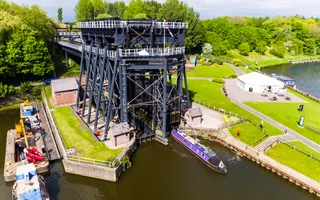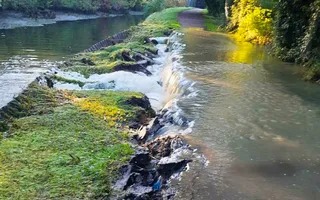Behind the scenes on the River Tees
Last year, engineering journalist, Mark Evans, was given a rare behind-the-scenes look at our maintenance team in action, as they carried out essential works at the Tees Barrage in County Durham.
The charity making life better by water
Making life better by water
Hot off the press, it’s our latest Regional Round Up, bringing you news, views, and insights from a canal near you. This time, we’re seeing what it takes to maintain our 250-year-old network.
Last year, engineering journalist, Mark Evans, was given a rare behind-the-scenes look at our maintenance team in action, as they carried out essential works at the Tees Barrage in County Durham.
The annual inspection involved servicing and maintaining the four giant steel gates that sit beneath the bridge and help to control the flow of the river.
As Mark looked on, the team, led by project manager, Kevin Richardson, got to work. They began by draining all the water out of the gates, a lengthy, complicated process carried out in the early hours to minimise disruption to residents. After a well-earned break and a quick round of bacon rolls, Mark and the team were back to complete a thorough inspection of each of the 50-tonne gates.
This included pressure testing, checking the seals, and scraping off any barnacles. There was also the ‘small matter’ of swapping out the flushing valves for the first time in the barrage’s 30-year history.
Since its construction, the Tees Barrage has transformed the River Tees improving the quality of the water and helping local wildlife flourish. However, as Mark discovered, servicing and maintaining a structure of this magnitude can be costly. With your continued support, we hope to keep this vital piece of our infrastructure operational for years to come.
Here's another chance to enjoy our Step Behind the Scenes videos.
The refurbishment of Anderton Boat lift took a step closer this summer after initial investigatory work got underway. One of the seven wonders of our waterways, Cheshire’s iconic boat lift needs a major overhaul if it’s to remain open to the public.
Built in 1875, for over a century, Anderton Boat Lift transported vessels between the Trent & Mersey Canal and the River Weaver. Sadly, in 1983, Cheshire’s ‘Cathedral of the Canals’ was forced to close, sitting idle for the next two decades.
Restored in 2002, Cheshire’s famous boat lift has enjoyed a new life as a popular tourist destination, attracting thousands of visitors every year. But now, 20 years on from its grand reopening, this treasured local landmark is once again in need of a refurbishment.
To keep it open and operational, the whole structure needs blast cleaning, repairing and repainting, the timber control cabin needs replacing, and the IT systems need updating.
Thanks to all of you who responded to our appeal last year, repair work and extensive survey works are underway, with the help of specialist engineering firm, JN Bentley. Right now we’re looking to build on this kind support by securing additional funding for a full restoration in the autumn of next year. The Trust has ambitious plans to keep this incredible piece of our canal heritage alive for future generations and enable more visitors to enjoy this unique attraction.
In September, we completed major repairs to a section of the Grand Union Canal in Leicester, after it was washed away by winter floods. The damage, near Blue Bank Lock, is yet another example of the havoc climate change is wreaking across our ageing network.
Last winter was one of the wettest on record, with no fewer than 12 named storms tearing across the country. The East Midlands was badly hit, with a succession of storms bringing torrential rainfall and causing the River Soar, which runs parallel to the Grand Union Canal, to burst its banks. Near Blue Bank Lock, south of Leicester, the flood waters scoured away part of the towpath and the canal wall, making the route impassable.
We acted quickly to resolve the situation, beginning a £500,000 programme of repairs overseen by Asset Engineer, Sidney Pereira at the beginning of the year. A 100-metre section of the canal wall was reinforced with new steel piling and backfilled with stone, to guard against future incidents. Thanks to Leicester City Council, who provided nearly £44,000 of funding, the towpath, a popular route with pedestrians and cyclists, has been reinstated.
“This is an example of the devastating impact flooding brought about by climate change can have on our historic waterways,” says regional director, Linny Beaumont. “It also emphasises the need for continued support if we’re to keep them navigable and secure all the benefits they bring to local people and wildlife.”
Last Edited: 1 November 2024

Sign up to our newsletter and discover how we protect canals and help nature thrive




